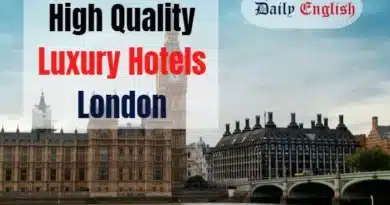Where Does King Charles III currently live?
King Charles III and Queen Camilla primarily reside at Clarence House in London, a historic mansion built between 1825 and 1827. Although Buckingham Palace serves as the official administrative headquarters for the monarchy, the King prefers Clarence House as his main home while Buckingham Palace undergoes renovations. In addition to Clarence House, the King has several other residences across the UK, including Highgrove House in Gloucestershire, Windsor Castle in Berkshire, and Sandringham House in Norfolk.

Key Takeaways
| Key Takeaway | Description |
|---|---|
| Primary Residences | |
| Clarence House | King Charles III and Queen Camilla’s primary London residence, offering a more intimate setting. |
| Buckingham Palace | Official London residence undergoing major renovations until 2027, impacting its role as the monarch’s primary residence. |
| Windsor Castle | Significant royal residence, currently hosting state visits and official events due to Buckingham Palace renovations. |
| Other Notable Residences | |
| Highgrove House | Private residence in Gloucestershire, known for organic gardens and reflecting the King’s commitment to sustainability. |
| Sandringham House | Private residence in Norfolk, traditionally used for Christmas celebrations. |
| Balmoral Castle and Birkhall | Private residences in Scotland, used for summer retreats. |
| Palace of Holyroodhouse | Official residence in Scotland. |
| Hillsborough Castle | Official residence in Northern Ireland. |
| Llwynywermod | Official residence in Wales. |
| New York City Condominium | Recent acquisition, raising questions about its purpose. |
| Impact of Buckingham Palace Renovations | |
| State visits and official events | Relocated to Windsor Castle during renovations. |
| King’s private office | Temporarily moved to Buckingham Palace. |
| Future of Buckingham Palace | Uncertain as the primary residence after renovations. |
| King Charles III’s Vision for the Monarchy | |
| Balance | Between tradition and modernity. |
| Focus | On personal comfort and practicality. |
| Commitment | To environmental sustainability. |
| Public Perception and Royal Duties | |
| Residence choice | Influences public perception and the execution of royal duties. |
| Buckingham Palace | Symbolizes national identity and continuity. |
| Clarence House | Offers a more intimate and personal setting. |
Monarch Residences
King Charles III, the reigning monarch of the United Kingdom, maintains a diverse portfolio of residences across the UK, each serving distinct purposes and reflecting his personal preferences and royal duties.
Clarence House
Located in London, Clarence House has been the primary residence of King Charles III and Queen Camilla since 2003. Built between 1825 and 1827, this historic mansion was previously the home of the Queen Mother. While Buckingham Palace serves as the official administrative headquarters of the monarchy, the King and Queen have chosen to continue residing at Clarence House during the extensive renovations of Buckingham Palace, which are expected to continue until at least 2027.
Buckingham Palace
As the official London residence of the British monarch, Buckingham Palace is undergoing a significant £369 million refurbishment, projected to last until 2027. State visits and official events are being relocated to Windsor Castle during this period. The King’s private office has been moved to the Belgian Suite on the palace’s ground floor, where he was born. Despite the renovations, Buckingham Palace remains the central hub for the monarchy’s administrative functions.
Windsor Castle
In Berkshire, Windsor Castle is one of the world’s oldest and largest inhabited castles. It serves as both a private and official royal residence, hosting state visits and ceremonies. During the refurbishment of Buckingham Palace, Windsor Castle has taken on an increased role in accommodating official events.
Highgrove House
Located in Gloucestershire, Highgrove House has been a significant residence for King Charles III since 1980. Owned by the Duchy of Cornwall, the estate is renowned for its extensive gardens, reflecting the King’s commitment to organic farming and environmental sustainability. With the Prince of Wales now holding the Duchy, King Charles is expected to pay rent to continue using Highgrove House.
Sandringham House
Sandringham House in Norfolk is a private residence of the monarch, traditionally used as a retreat during the Christmas season. The estate has been owned by the royal family since 1862 and is known for its expansive grounds and location where the royal family spends Christmas.
Balmoral Castle and Birkhall
In Scotland, Balmoral Castle in Aberdeenshire serves as a private residence for the royal family, traditionally used during the summer months. Adjacent to Balmoral is Birkhall, which was previously owned by Queen Elizabeth, the Queen Mother, and inherited by King Charles III in 2002. Birkhall has been a favoured retreat for the King, reflecting his appreciation for Scottish heritage and natural landscapes.
Palace of Holyroodhouse
Located in Edinburgh, the Palace of Holyroodhouse is the official residence of the British monarch in Scotland. King Charles III spends one week there at the beginning of each summer, where he carries out a range of official engagements and ceremonies.
Hillsborough Castle
Hillsborough Castle in County Down serves as the official royal residence in Northern Ireland. The house was built in the late 18th century by the Hill family and sold to the British government in the 1920s. The royal family uses it during official visits to Northern Ireland.
Llwynywermod
In Wales, Llwynywermod, located near the village of Myddfai in Carmarthenshire, is the residence of the Prince and Princess of Wales. The Duchy of Cornwall purchased the property in 2007 and used it by the royal family during their visits to Wales.
Recent Acquisition in New York City
In July 2024, it was reported that King Charles purchased a luxury condominium in Manhattan’s prestigious Billionaires’ Row for $6.63 million. The condo, located on the 11th floor at 111 W. 57th St, is part of Steinway Hall. The buyer is listed as “His Majesty the King in Right of Canada, Represented by the Minister of Foreign Affairs,” raising questions about whether the home will belong to the King himself or Canada.
Each of these residences holds historical significance and serves various functions, from official duties to private retreats, reflecting the multifaceted role of the monarchy in the United Kingdom.
King Charles III’s Current Residence
Clarence House: A Historical Overview
Clarence House, situated adjacent to St. James’s Palace in London, was constructed between 1825 and 1827. Designed by the esteemed architect John Nash, it was commissioned by Prince William Henry, Duke of Clarence, who later ascended the throne as King William IV. Over the years, Clarence House has been home to several royal family members, including Queen Elizabeth The Queen Mother, who resided there for nearly five decades until her passing in 2002. In 2003, King Charles III and Queen Camilla took up residence, making it their primary London home.

Reasons for Choosing Clarence House
King Charles III and Queen Camilla’s decision to reside at Clarence House is influenced by several factors:
- Historical Continuity: The residence’s rich history and familial connections offer a sense of continuity and tradition.
- Practicality: Clarence House provides a suitable environment for their lifestyle and official duties, especially during the extensive renovations at Buckingham Palace.
- Personal Preference: The King and Queen have expressed comfort and attachment to Clarence House, preferring its ambience and location.
Buckingham Palace: The Traditional Royal Residence
History of Buckingham Palace as a Royal Residence
Buckingham Palace’s origins trace back to the early 18th century when it was a private house built for the Duke of Buckingham. In 1761, King George III acquired the house for his wife, Queen Charlotte, transforming it into a royal residence known as the “Queen’s House.” Over the centuries, it underwent significant expansions, becoming the official London residence of the British monarch in 1837 with Queen Victoria’s accession. Since then, it has served as the administrative headquarters of the monarchy and the venue for state occasions and royal hospitality.
Buckingham Palace: Advantages and Challenges
- Advantages:
- Symbolic Significance: Buckingham Palace embodies national identity and continuity as a central symbol of the British monarchy.
- Capacity: With 775 rooms, including 19 staterooms, it accommodates large-scale events and official functions and provides office space for the royal household.
- Challenges:
- Ageing Infrastructure: The palace is currently undergoing a significant £369 million refurbishment to address outdated electrical wiring, plumbing, and heating systems, which is expected to be completed by 2027.
- Suitability for Modern Living: Buckingham Palace’s grandeur may not align with contemporary family life, presenting challenges in terms of comfort and practicality.
The Future of King Charles III’s Residence

Potential Move to Buckingham Palace
Traditionally, Buckingham Palace has been the primary residence of the reigning monarch. However, King Charles III has expressed reservations about relocating there permanently, even after the completion of renovations. Factors influencing this decision include the suitability of the palace for modern living and the personal comfort found at Clarence House.
Possible Long-Term Use of Clarence House
Given their preference, King Charles III and Queen Camilla may continue to use Clarence House as their primary London residence. This choice reflects a shift towards a more personal and less formal approach to royal habitation, aligning with the King’s vision of a modernized monarchy.
Conclusion: King Charles III’s Residence – A Reflection of Modern Monarchy
King Charles III’s residential choices signify a nuanced approach to tradition and modernity. By potentially favouring Clarence House over Buckingham Palace, he acknowledges the importance of personal comfort and practicality while respecting historical significance.
The monarch’s residences are more than mere buildings; they are symbols of the monarchy’s relationship with the nation. King Charles III’s choices reflect his commitment to a monarchy that balances tradition with contemporary relevance.
FAQ
Where does King Charles III primarily reside?
King Charles III and Queen Camilla have lived at Clarence House in London since 2003. Built between 1825 and 1827, it occasionally opens to the public during the summer.
Does King Charles III live in Buckingham Palace?
No, King Charles III has chosen not to live in Buckingham Palace. While it serves as the monarchy’s administrative headquarters, the King and Queen prefer to reside at Clarence House.
What is the status of Buckingham Palace’s refurbishment?
Buckingham Palace is undergoing a £369 million, ten-year refurbishment project, which includes phased closures of some of its grandest rooms. As a result, no state visits will be hosted until 2027, with official visits redirected to Windsor Castle.
Does King Charles III own Sandringham House?
Yes, Sandringham House in Norfolk is part of the royal estate and is privately owned by King Charles III. It was passed to him after Queen Elizabeth II’s death.
What are King Charles III’s residences in Scotland?
King Charles III has several residences in Scotland, including Birkhall, the Palace of Holyroodhouse, and Balmoral Castle. Balmoral Castle is notable as the place where Queen Elizabeth II passed away in 2022.
Does King Charles III have a residence in Wales?
Yes, Llwynywermod in Wales is an estate owned by King Charles III. He purchased it in 2007, and it serves as his Welsh residence.
What is the significance of Windsor Castle for King Charles III?
Windsor Castle in Berkshire is a notable residence of King Charles III. Built-in the 11th century, it was passed to him after Queen Elizabeth II’s death. The castle also hosted state visits during the refurbishment of Buckingham Palace.
Does King Charles III have a residence in Northern Ireland?
Yes, Hillsborough Castle serves as the official royal residence in Northern Ireland. It is used whenever the royal family undertakes official duties in the region.
What is the purpose of Highgrove House for King Charles III?
Highgrove House in Gloucestershire is one of King Charles III’s notable homes. It has been his private residence since the 1980s and reflects his commitment to organic farming and environmental sustainability.
Does King Charles III own properties in London beside Clarence House?
Yes, Kensington Palace in London is part of the royal estate. While primarily the Prince and Princess of Wales’s residence, it remains a significant royal property.
Does King Charles III have a residence in Transylvania?
Yes, King Charles III owns a property near the village of Viscri in Romania’s Transylvania region. He purchased and restored the property, reflecting his interest in conservation and sustainable tourism. The property is available for public rental, offering an authentic experience of rural Transylvanian life.
What is the significance of St James’s Palace for King Charles III?
St James’s Palace in London is a senior royal palace and remains the ceremonial royal residence. It is the site of the Accession Council and is used by other royal family members. Foreign ambassadors are accredited to the Court of St James’s.
Does King Charles III have a residence in Northern Ireland?
Yes, Hillsborough Castle in County Down serves as the official royal residence in Northern Ireland. It is used whenever the royal family undertakes official duties in the region.
What is the role of the Palace of Holyroodhouse in King Charles III’s residency?
The Palace of Holyroodhouse in Edinburgh is the monarch’s official residence in Scotland. King Charles III stayed at Holyrood for at least one week each year and when visiting Scotland on state occasions.
Does King Charles III own Highgrove House?
The Duchy of Cornwall owns Highgrove House in Gloucestershire. King Charles III has used it as his private residence since the 1980s, reflecting his commitment to organic farming and environmental sustainability.
What is the significance of Sandringham House for King Charles III?
Sandringham House in Norfolk is privately owned by King Charles III. It was inherited from Queen Elizabeth II upon her death. The royal family traditionally uses the estate during Christmas celebrations.
Does King Charles III have a residence in Wales?
Yes, Llwynywermod in Wales is the private residence of King Charles III. He purchased it in 2007 and used it as his base in Wales.
What is the status of Buckingham Palace’s refurbishment?
Buckingham Palace is undergoing a ten-year refurbishment project, including extensive rewiring and plumbing upgrades. The project is expected to be completed around 2027.
Does King Charles III reside at Buckingham Palace?
Currently, King Charles III has chosen to reside at Clarence House in London. While Buckingham Palace serves as the monarchy’s administrative headquarters, the King and Queen prefer the more intimate setting of Clarence House.
What is the significance of Windsor Castle for King Charles III?
Windsor Castle in Berkshire is one of the official residences of King Charles III. It is used for hosting state visits and official events, especially during the refurbishment of Buckingham Palace.










Comments are closed.